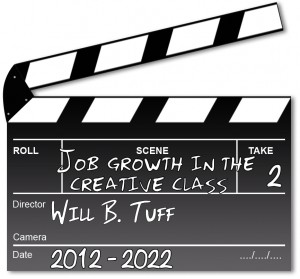Marlowsphere Blog (#122)
The last Marlowshpere blog (#121) took an overall look at job growth/job prospects for those in the so-called “creative class.” This is an appropriate time of year to do so given that  May and early June are when college students attend graduation commencement ceremonies.
May and early June are when college students attend graduation commencement ceremonies.
In this blog I take a specific look at those wishing to enter the fine and performing arts.
There are hundreds of colleges and universities in the United States that offer undergraduate and
graduate degrees in all manner of fine and performing arts disciplines. But earning a degree in dance, graphics design, music, photography, acting, and other fine arts is no guarantee of success. Unlike degrees in various technologies, the sciences, medicine, engineering, accounting, et al, where demand is strong, success in the fine and performing arts may be enhanced by higher education study, but it is far, far from a guarantee.
The hard fact is only a very small portion of those who pursue the fine and performing arts as a lifelong endeavor achieve a modicum of professional and financial success. And given the impact and unintended consequences of electronic technologies, such as the Internet, even a smaller percentage achieves mega professional and financial success. The fine and performing arts are not safe endeavors. Despite the overwhelming odds against success, however, many do pursue the life of an artist.
Below are the expected job growth/job prospects for those who wish to pursue a life in the fine and performing arts according to the Occupational Outlook Handbook, 2012-2022. All descriptions below are drawn directly from this aforementioned Federal government source.
Job Growth/Job Prospects: The Fine & Performing Arts
- Dancers and Choreographers: +13%
- Graphic Designers: +7%
- Music Directors and Composers: +5%
- Musicians and Singers: +5%
- Photographers: +4%
- Actors: +4%
- Craft & Fine Artists: +3%
Dancers & Choreographers: +13%
![ballet-dance-silhouette-clip-art[1]](http://www.eugenemarlow.com/wp-content/uploads/2015/05/ballet-dance-silhouette-clip-art1-138x300.jpg) Employment of dancers is projected to grow 6 percent from 2012 to 2022, slower than the average for all occupations. Employment of choreographers is projected to grow 24 percent from 2012 to 2022, much faster than the average for all occupations. Dance companies are not expected to add many jobs over the decade. Generally, when one company disappears, a new one replaces it, without any change in the total number of companies. There may be better opportunities for dancers and choreographers in large cities, such as New York and Chicago, with many dance companies and performances.
Employment of dancers is projected to grow 6 percent from 2012 to 2022, slower than the average for all occupations. Employment of choreographers is projected to grow 24 percent from 2012 to 2022, much faster than the average for all occupations. Dance companies are not expected to add many jobs over the decade. Generally, when one company disappears, a new one replaces it, without any change in the total number of companies. There may be better opportunities for dancers and choreographers in large cities, such as New York and Chicago, with many dance companies and performances.
A growing interest in dance in pop culture may provide opportunities in fields outside of dance companies, such as TV or movies, casinos, or theme parks. Many dancers and choreographers, nonetheless, struggle to find opportunities to express themselves creatively; newer dance companies rely on word-of-mouth, grants, and public funding. However, public funding and grants for dance performances can be highly competitive.
The growing interest in dance in pop culture is expected to lead more people to enroll in dance schools, and growing enrollment should create more jobs for choreographers. Dancers and choreographers face intense competition, and the number of applicants is expected to vastly exceed the number of job openings.
Dancers who attend schools or conservatories associated with a dance company may have a better chance of finding work at that company than others.
 Musicians & Singers: +5%
Musicians & Singers: +5%
Employment of musicians and singers is projected to grow 5 percent from 2012 to 2022, slower than the average for all occupations. Growth will be due to increases in demand for musical performances.
Digital downloads and streaming platforms make it easier for fans to listen to recordings and view performances. Easier access to recordings gives musicians more publicity and grows interest in their work, and concertgoers may become interested in seeing them perform live.
There will be additional demand for musicians to serve as session musicians and backup artists for recordings and to go on tour. Singers will be needed to sing backup and to make recordings for commercials, films, and television.
However, employment growth will likely be limited in orchestras, opera companies, and other musical groups because they can have difficulty getting funding. Some musicians and singers work for nonprofit organizations that rely on donations, government funding, and corporate sponsorships in addition to ticket sales to fund their work. During economic downturns, these organizations may have trouble finding enough funding to cover their expenses.
There will be tough competition for jobs because of the large number of workers who are interested in becoming musicians and singers. In particular, there will likely be considerable competition for full-time positions.
Musicians and singers with exceptional musical talent and dedication should have the best opportunities.
 Music Directors & Composers: +5%
Music Directors & Composers: +5%
Employment of music directors and composers is projected to grow 5 percent from 2012 to 2022, slower than the average for all occupations.
The number of people attending musical performances, such as symphonies and concerts, and theatrical performances, such as ballets and musical theater, is expected to increase moderately. Music directors will be needed to lead orchestras for concerts and musical theater performances. They will also conduct the music that accompanies ballet troupes and opera companies.
In addition, there will likely be a need for composers to write original music and arrange known works for performances. Composers are also expected to be needed to write film scores and music for television and commercials.
However, growth is expected to be limited because orchestras, opera companies, and other musical groups can have difficulty getting funds. Some music groups are nonprofit organizations that rely on donations and corporate sponsorships, in addition to ticket sales, to fund their work. These organizations often have difficulty finding enough money to cover their expenses. In addition, growth may be limited for music directors who work for public schools because state and local governments continue to struggle with school budgets.
Despite expected growth, tough competition for jobs is anticipated because of the large number of people who are interested in entering this field. In particular, there will be considerable competition for full-time positions. Those with exceptional musical talent and dedication should have the best opportunities. Many music directors and composers experience periods of having no work; during these times, they may work in other occupations, attend auditions, or write music.
Photographers: +4%
Employment of photographers is projected to grow 4 percent from 2012 to 2022, slower than the average for all occupations.  Overall growth will be limited because of the decreasing cost of digital cameras and the increasing number of amateur photographers and hobbyists.
Overall growth will be limited because of the decreasing cost of digital cameras and the increasing number of amateur photographers and hobbyists.
Improvements in digital technology reduce barriers of entry into this profession and allow more individual consumers and businesses to produce, store, and access photographic images on their own.
Employment of self-employed photographers is projected to grow 4 percent from 2012 to 2022. Demand for portrait photographers will continue as people continue to need new portraits. In addition, corporations will continue to require the services of commercial photographers to develop compelling advertisements to sell products.
Declines in the newspaper industry will reduce demand for news photographers to provide still images for print. Employment of photographers in newspaper publishing is projected to decline 36 percent from 2012 to 2022.
Photographers will face strong competition for most jobs. Because of reduced barriers to entry, there will be many qualified candidates for relatively few positions.
In addition, salaried jobs may be more difficult to obtain as companies increasingly contract with freelancers rather than hire their own photographers. Job prospects will be best for candidates who are multitalented and possess related skills such as picture editing and capturing digital video.
Actors: +4%
Employment of actors is projected to grow 4 percent from 2012 to 2022, slower than the average for all occupations. Job growth in the motion picture industry will stem from continued strong demand for new movies and television shows. However, employment is not expected to keep pace with that demand.
Production companies are experimenting with new content delivery methods, such as video on demand and online television, which may lead to more work for actors in the future. However, these delivery methods are still in their early stages, and it remains to be seen how successful they will be.
Actors who work in performing arts companies are expected to see slower job growth than those in film. Many small and medium-size theaters have difficulty getting funding. As a result, the number of performances is expected to decline. Large theaters, with their more stable sources of funding, should provide more opportunities.
Actors face intense competition for jobs. Most roles, no matter how minor, have many actors auditioning for them. For stage roles, actors with a bachelor’s degree in theater may have a better chance than those without one.
Craft & Fine Artists: +3%
Employment of craft and fine artists is projected to grow 3 percent from 2012 to 2022, slower than the average for all occupations.
Employment growth of artists depends in large part on the overall state of the economy, because purchases of art usually are optional. During good economic times, more people and businesses are interested in buying artwork; during economic downturns, they generally buy less.
Although there is always a demand for art by collectors and museums, the employment of artists can be affected by the level of charitable giving to the arts, which has been decreasing somewhat in recent years.
In addition, job growth for craft artists may be limited by the sale of inexpensive, mass-produced items designed to look like handmade American crafts. However, continued interest in locally made products and craft goods sold online will likely offset some of these employment losses.
Demand for illustrators who work on a computer will increase, as media companies use more detailed images and backgrounds in their designs. Illustrators and cartoonists who work in publishing may see job opportunities decline, as traditional print publications lose ground to other media forms. However, new opportunities are expected to arise, as the number of electronic magazines, Internet-based publications, and video games grows.
Competition for jobs as craft and fine artists is expected to be strong, because there are more qualified candidates than available jobs. Only the most successful craft and fine artists receive major commissions for their work.
Despite the competition, studios, galleries, and individual clients are always on the lookout for artists who display outstanding talent, creativity, and style. Talented individuals who have developed a mastery of artistic techniques and marketing skills will have the best job prospects.
Competition among artists for the privilege of being shown in galleries is expected to remain intense, as will competition for grants from funders, such as private foundations, state and local arts councils, and the National Endowment for the Arts. Because of their reliance on grants, and because the demand for artwork is dependent on consumers having extra income to spend, many of these artists will find that their income changes with the overall economy and the federal budget.
If you have any questions or comments about this or any other of my blogs, please write to me at
meiienterprises@aol.com.
Eugene Marlow, Ph.D.
May 18, 2015
© Eugene Marlow 2015

